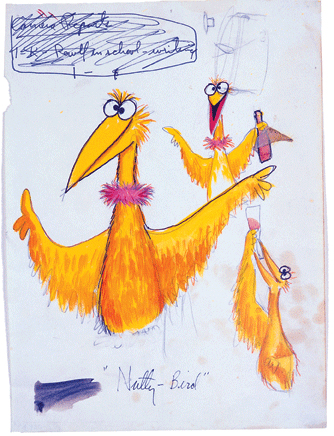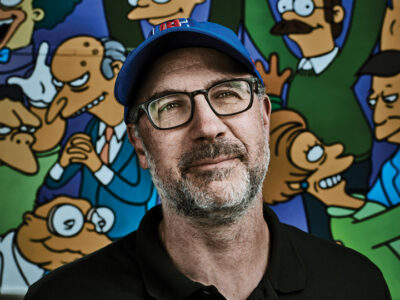
Class of ’84 | Back in the 1980s, when she worked at Christie’s auction house—a logical progression from her Penn degree in museum curatorship—Karen Falk C’84 G’84 used to notice the “guys in Kermit the Frog jackets” coming in and out of the Jim Henson Company’s puppet workshop, just down the street from her Manhattan office. Though a “little too old” for Sesame Street, she loved the characters and humor of The Muppet Show. “I thought, ‘Gosh, I would love to work for the Muppets, but what could I do?’”
As it turned out, Falk has found plenty to do in her 15 years as archivist for the Jim Henson Company, which makes the Muppets and does other animatronics and computer-graphics work, and as a board member of The Jim Henson Legacy, a separate foundation created a few years after Henson’s death in 1990 to preserve his contributions to entertainment and technology. That includes putting together a major exhibition of work spanning the entire course of Henson’s four-decade career, “Jim Henson’s Fantastic World,” which opened in September at the Arkansas Art Center in Little Rock and will travel to 10 cities through 2010.
At Penn, Falk majored in American civilization, with a minor in art history; she was in a combined undergraduate and master’s degree program focused on museum studies. “It was a very specific material-culture studies, curatorial track, learning to work with museums,” she recalls, and an ideal preparation for her work at Christie’s after graduation. She was there for seven years, in a variety of positions, one of which was managing the auction house’s painting warehouse.
“I got to see thousands and thousands of paintings,” she says. “In an art-history course you might see a slide of one or two paintings by a really top artist. At Christie’s I saw the top artists, saw the not-so-well known, saw a lot of artists on a bad day—because those are the paintings changing hands.”
She was working in the firm’s museum-services division when she became intrigued with the Henson Company. She sent in a resume to the company’s exhibits department, which eventually hired her to organize its archive of materials.
“It was a nice fit, and that’s how I ended up switching over from the sublime to the ridiculous,” Falk says with a laugh. “It’s been a wonderful experience. It’s a family-run business, and I work very closely with the Henson family—his five children own the company—and I’ve been able to do a lot more than I expected to do in my field.”
The “Fantastic World” exhibition features 100 original drawings, cartoons, and storyboards by Henson. Although Falk had put together a smaller exhibit a decade ago (“Jim Henson’s Designs and Doodles”), and individual pieces and small groups of works had been lent to various institutions over the years, “We really wanted to put a bigger exhibit out there and have it travel around the country to make Jim’s work more available and tell his story to a bigger group of people,” she says. To handle the logistics, they partnered with SITES, the Smithsonian Institution Traveling Exhibition Services (see www.sites.si.edu for more information).
The idea was less about having “a big Muppet exhibit” and more about exploring Henson’s creative thinking, she says. “Our mission as the Jim Henson Legacy foundation is to really talk about Jim the man and his body of work and his creative process—and of course that covers a whole range of materials.” While Sesame Street and the Muppets have become pop-culture touchstones, and Henson films The Dark Crystal and Labyrinth have developed cult followings, Falk notes that his career actually began in 1954.
“Jim had a very successful career already when Sesame Street started in 1969,” she says. While the exhibit doesn’t stint on Henson’s later oeuvre, “there’s a lot of material in the exhibit about the first 20 years of Jim’s career,” including his early days in local TV in Washington and the “hundreds and hundreds” of television commercials he made in the late 1950s and the 1960s. (Falk’s own favorite Henson character, Ralph the Dog—who later appeared on Sesame Street—made his debut in a commercial for Purina Dog Chow.)
Also included is Henson’s work in experimental films, both live action and animated, during the 1960s. In the Oscar-nominated short film Timepiece, film footage and Henson’s storyboards run side-by-side on a video screen. “You can match frame by frame and really get an understanding of how he thought in images,” Falk says, “and how he was able to take his visual ideas and put them on the screen and make them available to other people to see and understand.”
While SITES is handling marketing, installation, and shipping of the new exhibit as it moves from venue to venue, Falk and other Henson Company and Legacy foundation staff are participating in various educational programs—with special emphasis on the show’s stay this coming summer at the Smithsonian’s International Gallery on the Mall in Washington. They plan to partner with local organizations—including, possibly, the Kennedy Center—to do “screenings, and lectures, and demonstrations and workshops, family programs,” Falk says.
Falk has also been heavily involved in marketing and product-licensing, efforts that contribute to the Henson Company’s bottom line and provide a range of new ways to reach a broader audience. For example, she has helped develop various “extra features” for DVD releases, such as packaging facsimiles of original archival documents with DVDs.
Another perk of the job has been that Falk—parent of two children, now 11 and 14, with investment banker Michael Goldman W’83—has been able to work part-time while they’ve been growing up.
“The Hensons have been really flexible with me, and in turn I’ve been able to do some really wonderful, fun stuff on my own schedule,” she says.
So, are the kids allowed to play with Henson’s stuff? “Certainly they love to come here,” replies Falk (who has obviously been asked this question before), “but no, nobody gets to play with the original art.”
—J.P.




